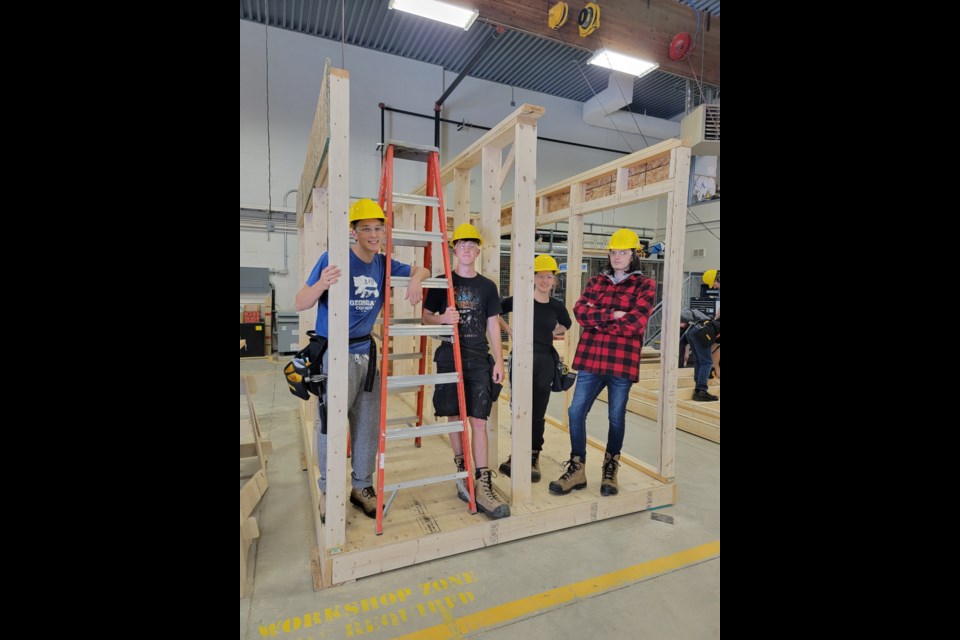The state-of-the-art, 7,000-square-foot carpentry shop at Georgian College's Muskoka campus could well be described as an ideal place for aspiring tradespeople to make their way into the hungry market for construction workers.
But the reality is far more inspiring.
“We see 120 general carpenter apprentices through our facility every year and many of them say when they work in the trades, every day is different,” said Michelle Kennedy, who's the academic support officer at the Bracebridge campus, home of the one-year certificate program called construction techniques.
Kennedy said apprentices always say they're having to find new and innovative ways to solve problems.
“The program is built around hands-on, project-based learning, which in academia we sometimes call ‘cumulative experiential learning,'" she told BarrieToday.
Kennedy said the program keeps everyone engaged the entire time, which is really great for students who typically enrol in such training programs.
“They like working with their hands and being busy and are not always overly thrilled about the theory portions," she said. "So, we try to keep them as engaged as possible.”
In one of the program projects, for instance, students frame tiny homes in carpentry, then run the electrical and plumbing, followed by work through HVAC and gas tech applications.
Kennedy said that the best way to describe the program is as a series of practical and fun projects that any tradesperson, or homeowner for that matter, would find extremely useful.
“The program is kind of a cumulative-run residential construction project," she said. "It's a series of smaller projects to work on something cumulatively.”
She also mentioned that the program provides a really great opportunity for somebody who might want to learn some basic skills for their own personal use.
“We had a gentleman in the program last year that was using the skills he learned to renovate his own house," Kennedy said.
On the technology side, the program exposes students to 3D design and scanning, digital fabrication and rapid prototyping, and equipment like CNCs (computer numerical control machines), and 3D printers.
“Being able to apply those adaptive and subtractive manufacturing techniques into the construction industry will be a huge competitive advantage in the coming decade,” said Muskoka campus manager James Fielding.
With the shortage in skilled workers, decreased production time frames and an emphasis on reducing material waste, Fielding pointed out that empowering people to bring modern manufacturing and rapid assembly on-site has become an important part of the construction trade.
“This integration of technology is something we see as critical in positioning our students for career success and being the future leaders of industry," he said.
The program allows students to explore the trades for a career, or to pick up useful skills to work on or manage projects in different sectors in the economy, Fielding added.
“That broad understanding of different trades not only helps students select their career, but also effectively communicate with other trades people on site to get the job done," he said.
Kennedy, meanwhile, believes that for a lot of tradespeople, having the opportunity to see a project through from start to finish is an amazing feeling.
“We know that wages are high and there's lots of opportunities in these trades, but hearing first-hand from our apprentices why they enjoy what they're doing is pretty special," she said.
Added Fielding: “Our students literally build the communities we live in and there's a tangible sense of accomplishment that comes along with the career."
The construction techniques program allows graduates to have the opportunity to enter the construction industry, pursue an apprenticeship in one of seven trades (cabinetmaker, carpenter, electrician, gas technician, HVAC technician, plumber, or small engine mechanic) as well as a draftsperson, or continue their college education in a trade-specific certificate, diploma, advanced diploma, or degree program.
The Ontario government recently estimated that more than 100,000 new skilled trades workers are needed to help deliver the province’s ambitious infrastructure plans this decade alone.
Bill Ferreira, executive director at BuildForce Canada, a national industry-led organization, says individuals can secure stable employment and enjoy highly competitive salaries by specializing in sought-after construction trades.
“In fact, there has never been a better time than now to find employment in the construction sector," he said.
Ferreira told BarrieToday that recent forecasts from BuildForce Canada show that nearly 300,000 trades workers will need to be recruited across the country over the next 10 years.
“Skilled workers are very much in demand, and those who show a passion for the work often find themselves taking on increasing complex roles, earning higher wages, and, in many cases, starting their own businesses," he added.
Ferreira also said that, beyond the opportunity and the salaries, there’s also a strong sense of purpose attached to work in the skilled trades.
“Ask anyone what it means to participate in the process of building and creating the roads, bridges, buildings, and pipelines that make up our communities and our society as a whole," he said.
Being in these trades brings a sense of pride that no other occupation can match, Ferreira noted.
“And that’s saying nothing of the contribution the industry is making toward net-zero carbon emissions, as well as its drive to enhance productivity through technology," he said.



